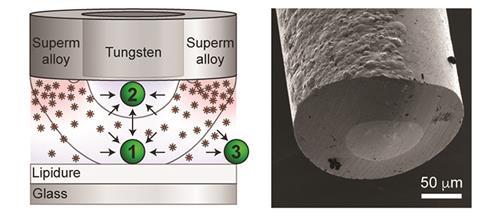Magnetofluidics offers new way to manipulate cells

An international team of scientists has used magnetic fields to manipulate unmodified, nonmagnetic living cells. This tool may revolutionise work in areas from tissue engineering to in vitro fertilisation.
The researchers, led by Bartosz Grzybowski from the Ulsan National Institute of Science and Technology, South Korea, are now able to move individual living cells without influencing their normal behaviour. Researchers can already move nonmagnetic objects to some extent but current methods inflict damage on living cells through heat or strong forces. Other magnetic methods require the use of toxic paramagnetic salts.
‘I like things people say are impossible, or things that look or sound oxymoronic,’ says Grzybowski. It certainly appears impossible to move a nonmagnetic object using a magnetic field. But place a ping-pong ball in a glass of water and bring a magnet close: the ball will move away, not because it is magnetic but because the water is more magnetic. The water exerts forces on the ball as the water molecules are attracted to the magnet.
The team applied this principle to exert forces on living cells without damaging or modifying them, using a non-toxic fluid composed of iron oxide nanoparticles coated with dextrin. The switchable magnetic field produced by the team’s ‘micropen’ concentrates this fluid in a ring when turned on, exerting a compressing force within the ring and a pushing force outside it. These forces help to pick up a nonmagnetic object.
Mike Hughes, a micromanipulation expert from the University of Surrey, UK, is cautiously optimistic. ‘The neat aspect of what they’ve done is the re-engineering of the medium to make it possible to trap cells,’ he says. ‘There may be ways in which the device might be usable for cell trapping, though the unusual medium may limit them.’
Indeed, the team can measure the adhesion force between two cells but also gather and arrange ordered clusters of cells rarely seen in nature. This may have use in producing artificial tissues with new properties, but a more significant impact may be on in vitroembryology where the symmetry of the initial collection of cells is important.
The group is now interested in gathering cells or bacteria together to investigate their interactions. In addition, Grzybowski acknowledges that there is no reason why the method could not manipulate nanoparticles, as it is not limited by the diffraction limit of light. He hopes that others will consider the possibilities of this technique in enabling future technologies.
References
This article is free to access
J V I Timonen et al, Nanoscale Horiz., 2016, DOI: 10.1039/c6nh00104a












No comments yet